Introduction
The DJI Ronin-M (Model: Ronin-M, FCC ID SS3-HG8001501) is a sophisticated handheld gimbal stabilizer crafted for filmmakers seeking smooth, cinematic camera movements. Engineered by DJI—a global leader in drone and camera stabilization technology—the Ronin-M provides advanced camera stabilization through precise motorized controls, making it ideal for professional filmmaking and content creation. With its FCC certification (FCC ID SS3-HG8001501), the Ronin-M meets stringent electromagnetic interference and RF emission standards, ensuring it is legally compliant for sale and use within the United States.
In this comprehensive analysis, we’ll explore the Ronin-M’s key specifications, wireless communication technologies, internal components through an expert teardown, and regulatory insights derived from FCC filings. Whether you’re a filmmaker, technical enthusiast, or engineer, this deep dive will provide valuable insights into what makes the Ronin-M a reliable and efficient camera stabilization solution.
Key Features & Specifications
Key Features:
- SmoothTrack Mode: Enables intuitive camera steering based on operator movements, with adjustable pan and tilt speeds.
- Briefcase Mode: Allows seamless transformation into a compact operational mode, ideal for tight spaces and portability.
- Auto Tune Stability: Automatically configures motor stiffness, trajectory, speed, and power for optimal camera stability.
- Remote Control: Customizable speed and deadband settings, independent pan and tilt speed adjustments, and endpoint adjustments.
- Motor Kill Switch: Enables quick mechanical adjustments without powering off the gimbal.
- Advanced Roll Adjustment: For cameras too light compared to the tilt motor assembly, ensuring proper balance.
- DJI Assistant App Integration: Provides wireless tuning of software parameters via Bluetooth connection.
Technical Specifications:
- Remote Control Battery Voltage: 3.45V – 3.53V
- Connectivity: Micro-USB port for PC/MAC connections; Bluetooth for wireless parameter tuning
- Supported Operating Systems: Windows XP, Win7, Win8 (32 or 64 bit), Mac OS X 10.9 or above
- Controller Priority Selection: Switchable priority between onboard and remote controllers
- Endpoint Adjustment: Independent pan and tilt axis endpoints, with full 360-degree pan capability
- Remote Control Features: 3-position mode and function switches, joystick controls, battery level indicators, micro-USB charging port
Additional Extracted Specifications:
- Bluetooth: Present (Details N/A)
Operating Frequencies
| Frequency Range (GHz) | Output Power (mW) | FCC Rule Part |
|---|---|---|
| 12.402-2.48 | 2.4 | 15CCC1.1 |
These operating frequencies suggest the Ronin-M utilizes standard Bluetooth technology, operating within the common 2.4 GHz ISM band, ensuring reliable short-range wireless communication.
Technology Deep Dive
The Ronin-M primarily leverages Bluetooth technology for wireless communication, allowing users to connect through the DJI Assistant App for parameter tuning and firmware updates. Bluetooth operates efficiently within the 2.4 GHz ISM band, providing stable, short-range connectivity with minimal power consumption. This ensures the Ronin-M maintains a reliable connection with minimal interference, essential for accurate and responsive adjustments during filming. The low output power (2.4 mW) further reduces interference risks and power draw, optimizing battery life and enhancing operational reliability during extended shoots.
In-Depth Internal Component Analysis / Teardown
The internal architecture showcases a compact PCB design densely populated with integrated circuits likely including microcontrollers and motor drivers crucial to precise gimbal control. The black multi-layer PCB reflects DJI’s typical consumer electronics standards, prioritizing signal integrity and power distribution efficiency. Connectors labeled ‘D.Bus/PPM’, ‘USB’, and ‘CAN’ indicate versatile external interfacing capabilities, facilitating integration with various control systems. The presence of capacitors and inductors emphasizes robust power management, ensuring stable voltage delivery essential for smooth motor operation and responsive stabilization.
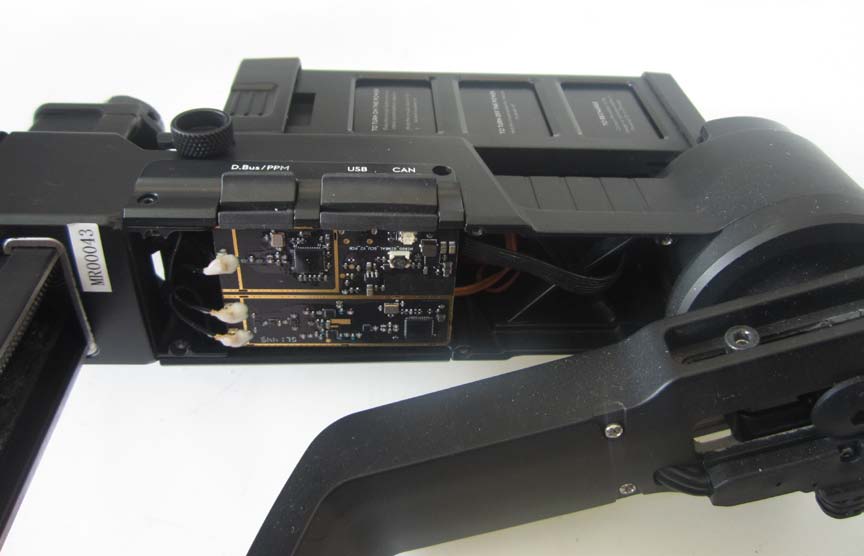
This board prominently features multiple coaxial connectors intended for external antenna connections, likely supporting Bluetooth communications. ICs in QFP or QFN packages suggest high-performance microcontrollers or SoCs managing core processing tasks. The meticulous routing of traces and substantial ground planes demonstrate careful attention to EMI mitigation and signal integrity. Additionally, a visible crystal oscillator provides stable clock signals for precise synchronization and timing, critical for accurate gimbal stabilization and responsive control.
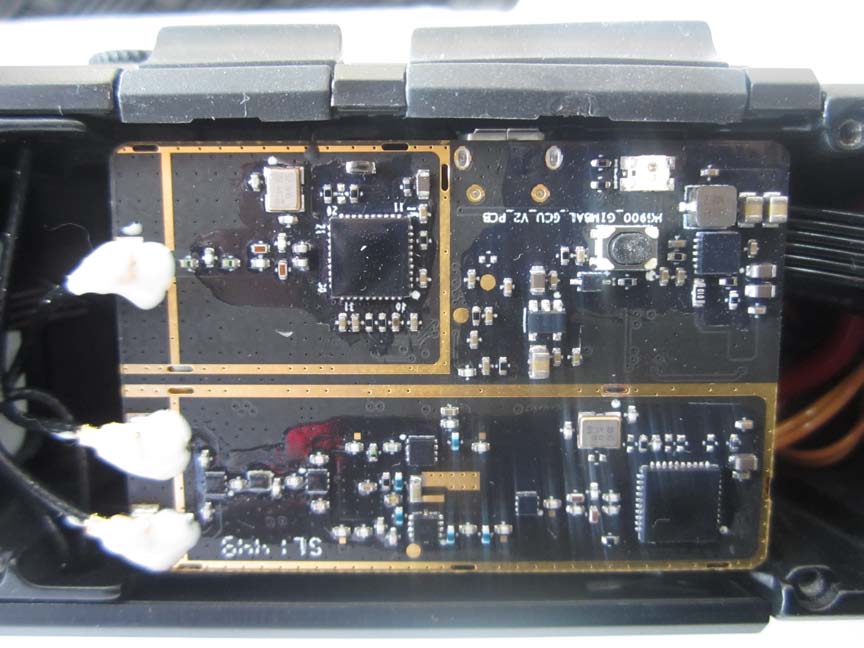
Central to this PCB is a micro USB connector, facilitating firmware updates and configuration via PC or Mac. Surrounding capacitors and inductors indicate robust power regulation circuits, managing stable voltages for the central microcontroller or SoC. Test points across the board allow efficient diagnostic procedures during manufacturing or maintenance, highlighting DJI’s focus on reliability and ease of servicing. The modularity suggested by connectors and pin headers aligns with the Ronin-M’s user-friendly design philosophy.
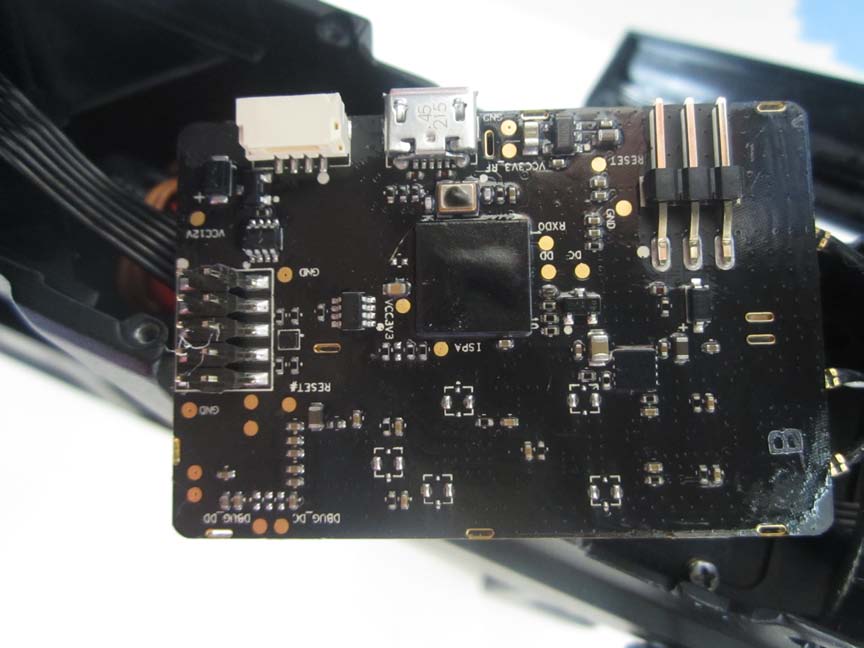
Designated as ‘HG900_GIMBAL_POWER_V1_PCB,’ this board emphasizes power distribution efficiency. Large capacitors visibly present underscore DJI’s commitment to voltage stabilization, critical for smooth motor operation. Its straightforward layout and robust connectors facilitate modular assembly and efficient repairability. The addition of white adhesive ensures mechanical stability and insulation, indicative of thoughtful engineering to withstand operational stresses.
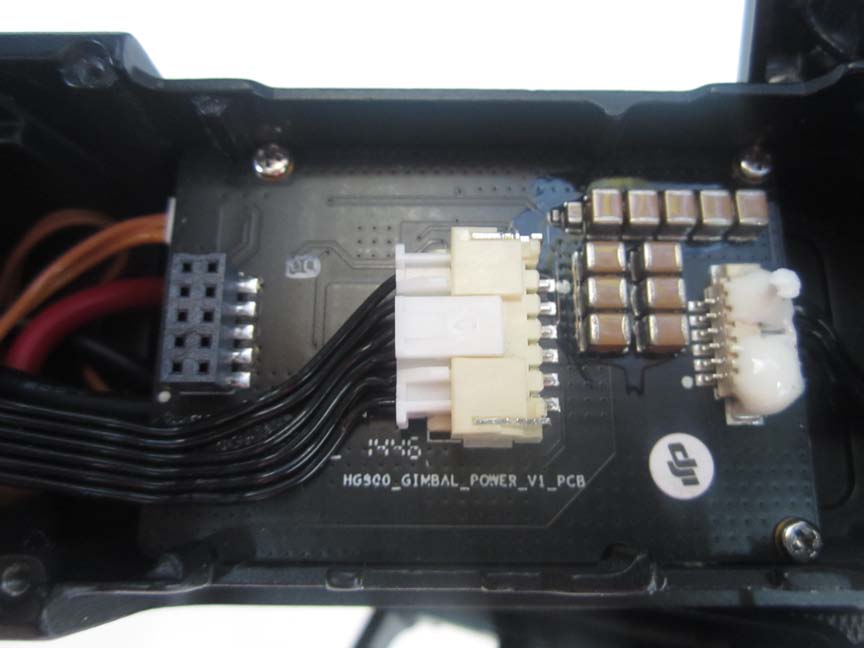
This board prominently features a large power inductor from Wurth Elektronik, paired with capacitors and voltage regulators, underscoring its primary role in power management. Such components ensure stable and clean power delivery, essential for the consistent performance of sensitive electronics within the Ronin-M. The compact and efficient layout of passive components further highlights DJI’s dedication to reliability and performance optimization in power circuitry.
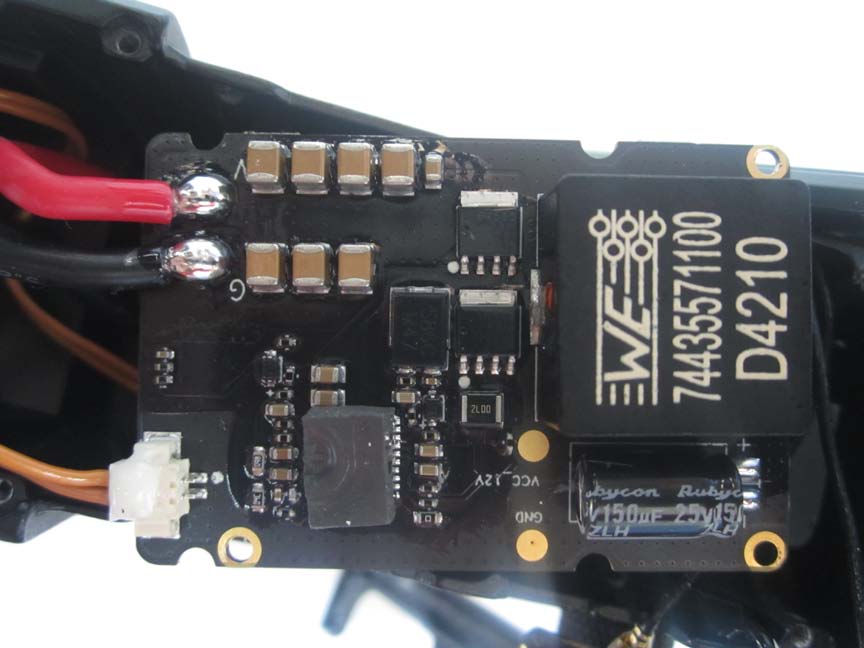
The final PCB analyzed reveals ICs likely responsible for motor control and precise stabilization functions. Surface-mounted microcontrollers or motor drivers, complemented by capacitors and inductors, indicate meticulous design for stable power and accurate motor operations. Ribbon cables and modular connectors emphasize ease of assembly and maintenance, aligning with DJI’s consistent focus on user-friendly hardware design for professional filmmaking applications.
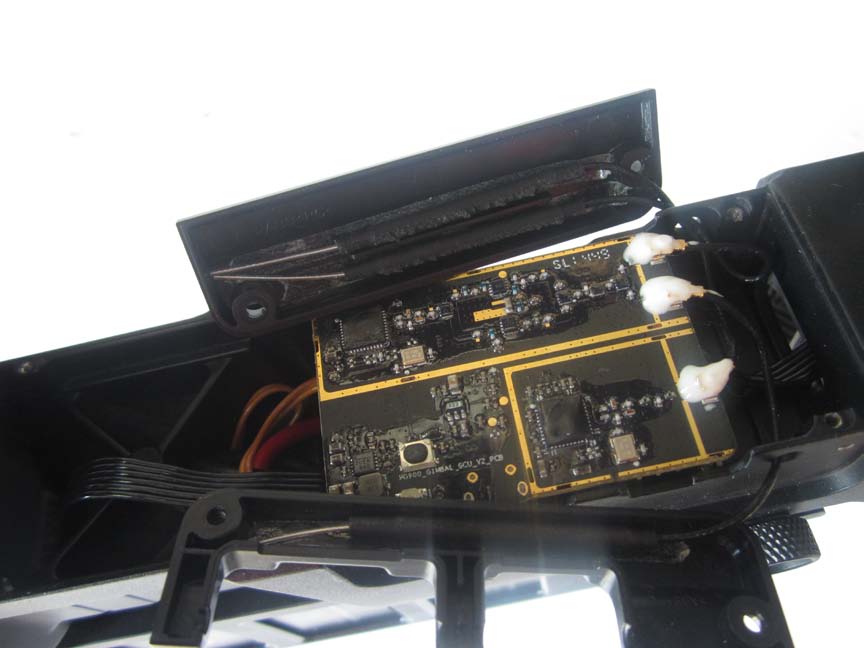
Regulatory Insights & FCC Filing
The Ronin-M’s FCC ID SS3-HG8001501 confirms compliance with the electromagnetic interference standards set by the FCC, ensuring safe and legal operation within the United States. FCC filings typically include detailed information such as RF exposure reports, EMC test results, internal and external photographs, operational manuals, schematics, and block diagrams. Insights from Ronin-M’s manuals emphasize critical operational guidelines, including balancing requirements, software tuning via Bluetooth, and operational modes like SmoothTrack and Briefcase Mode—highlighting DJI’s commitment to thorough documentation and regulatory adherence.
Potential Use Cases & Target Audience
- Professional Filmmakers: Leveraging SmoothTrack Mode for dynamic camera movements in cinema-quality productions, ensuring stabilized footage during action sequences.
- Event Videographers: Utilizing Briefcase Mode for seamless transitions in crowded or tight spaces, offering flexibility and operational efficiency.
- Content Creators & YouTubers: Benefiting from Auto Tune Stability for hassle-free setup, allowing quick adjustments and stable video outputs without extensive manual tuning.
Conclusion
The DJI Ronin-M (FCC ID SS3-HG8001501) stands as a testament to DJI’s expertise in camera stabilization technology. Its advanced features, robust internal components, and meticulous engineering ensure reliable performance suitable for professional filmmaking and content creation. With FCC certification affirming its compliance with regulatory standards, the Ronin-M remains a trusted solution for achieving cinematic-quality footage, solidifying its position in the market as a premium stabilization device.